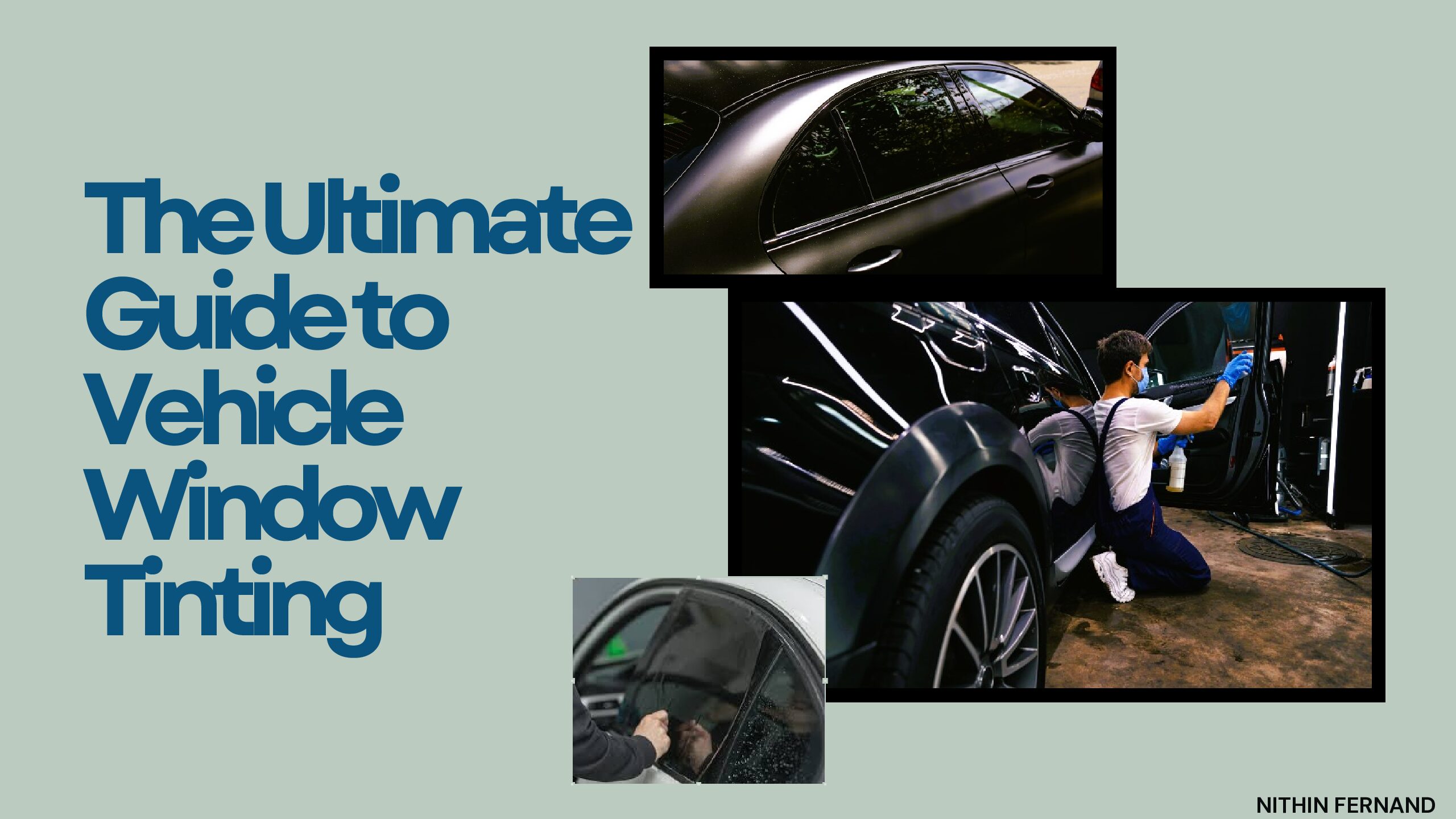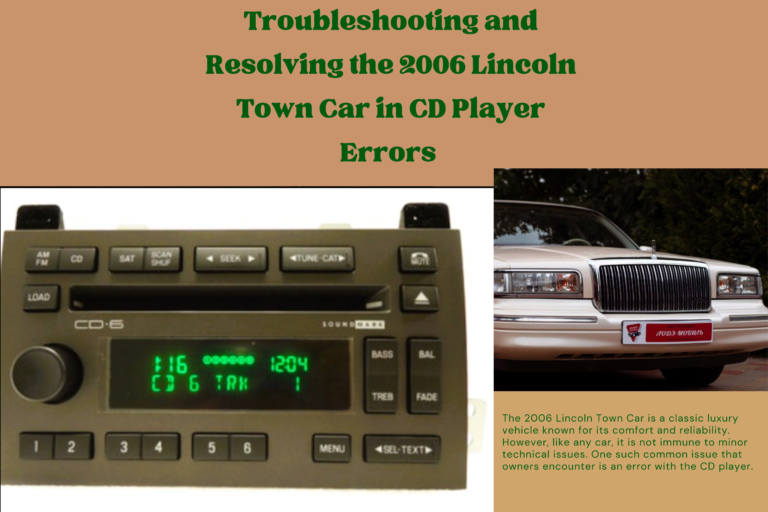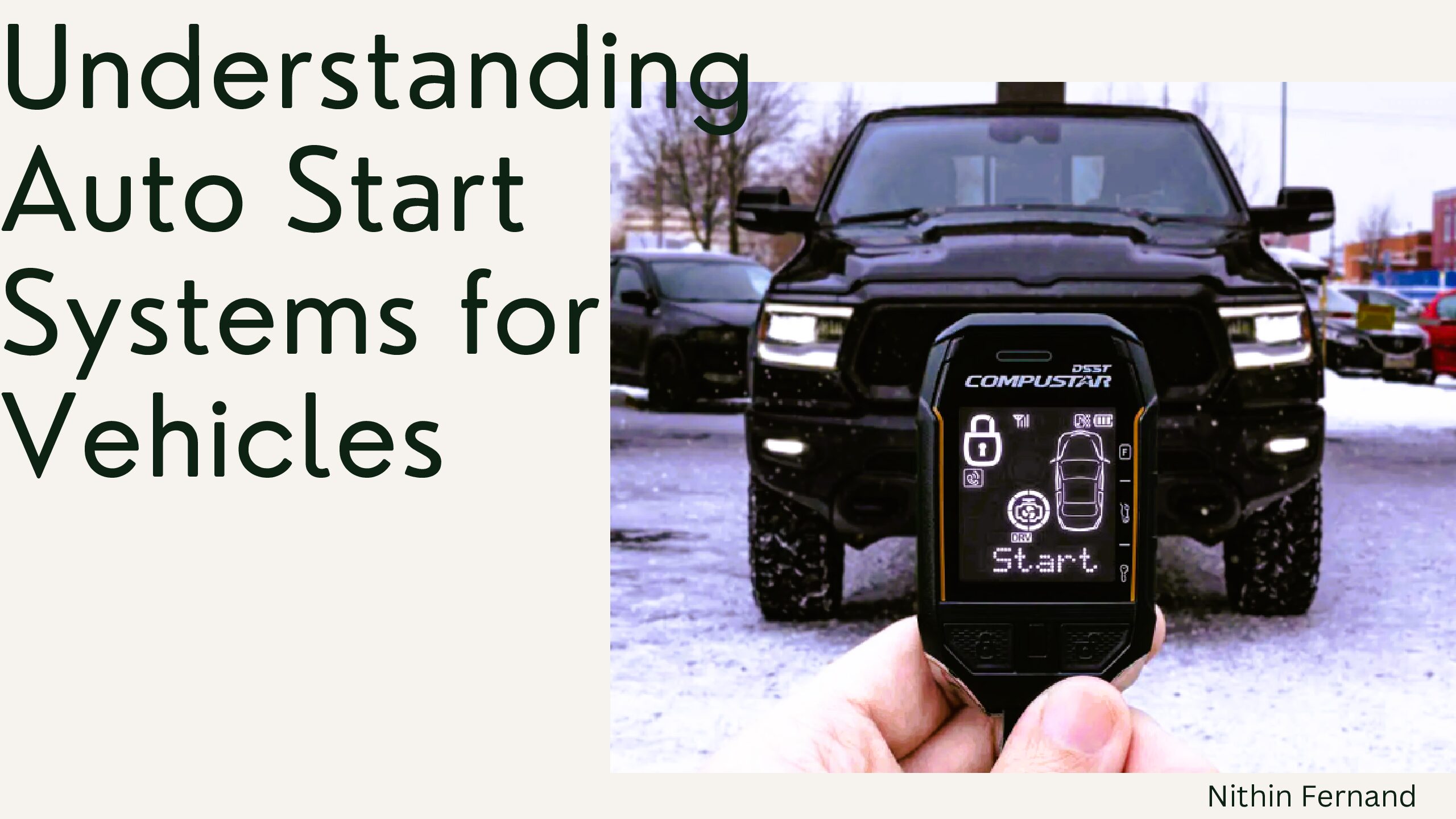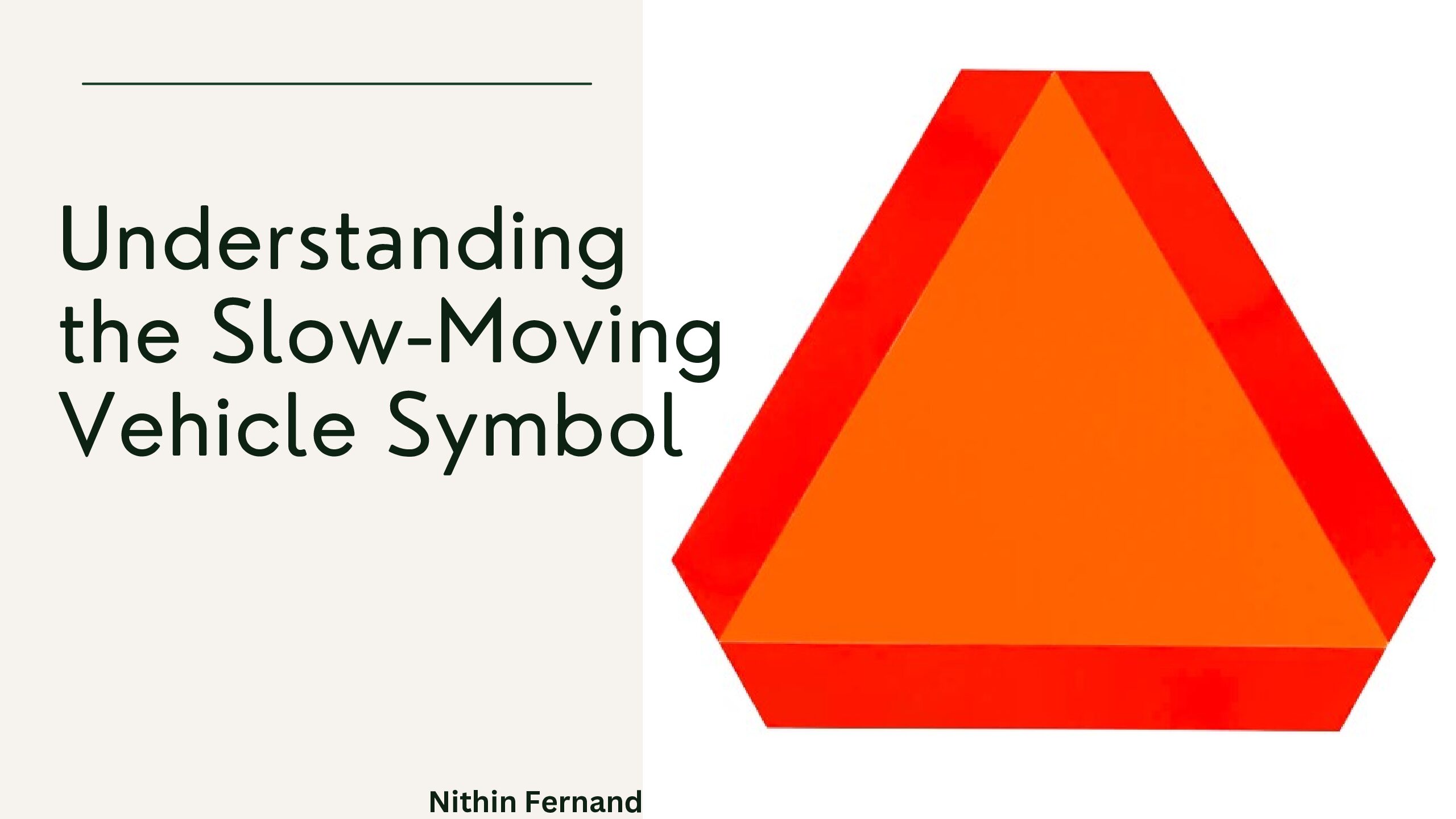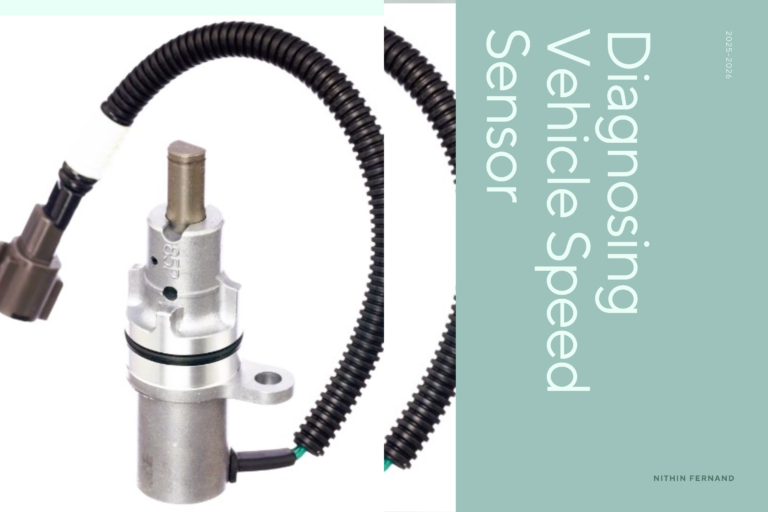The Ultimate Guide to Vehicle Window Tinting: Enhance Your Ride 2024
In today’s world, vehicle window tinting has become more than just a trend; it’s a practical enhancement that many car owners are opting for. Window tinting involves applying a thin film to the windows of a vehicle, which can significantly alter not only its appearance but also its functionality. From sleek aesthetics to improved comfort, the benefits of window tinting are numerous.
The importance of window tinting in modern vehicles extends beyond mere style. It provides critical privacy for passengers and valuable items within the car, shielding them from prying eyes. Additionally, window tinting offers protection from harmful UV rays, helping to safeguard both occupants and the interior of the vehicle from sun damage. As awareness about health and safety increases, more drivers are recognizing the value of investing in quality window tinting.
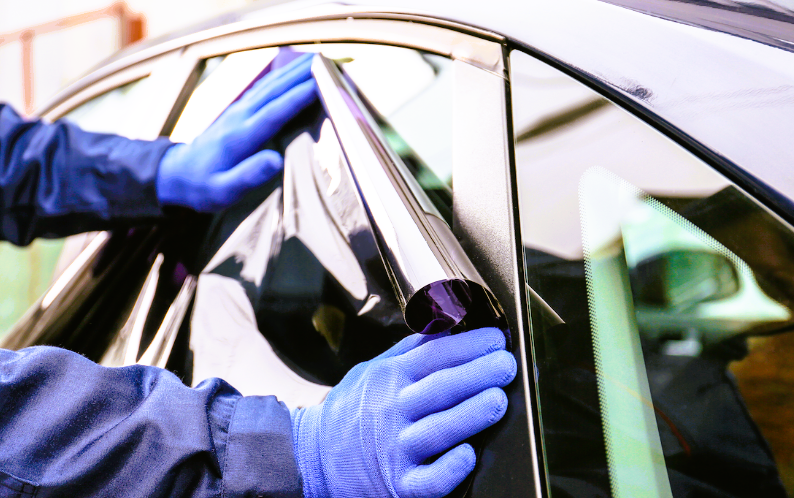
This article aims to provide a comprehensive overview of vehicle window tinting. We will explore its benefits, the different types available, the importance of legal compliance, how to choose the right tint, the tinting process, costs, and how to find reputable tinting services near you. Whether you’re looking to enhance your vehicle’s exterior, improve comfort, or protect your investment, this guide will equip you with the knowledge you need to make informed decisions about window tinting.
Table of Contents
What is Vehicle Window Tinting?
Definition of Window Tinting
Vehicle window tinting is the process of applying a thin film or coating to the windows of a vehicle to reduce light transmission, enhance privacy, and provide a range of protective benefits. This technique alters the way light enters the vehicle, allowing for greater control over the interior environment and increasing the safety and comfort of passengers. The application of window tinting can be done on various windows, including those found in cars, trucks, SUVs, and vans.
Explanation of the Types of Window Tint
There are several types of window tint available, each with unique properties and benefits. The most common types include:
- Dyed Window Tint
- Composed of a layer of dye between an adhesive and a protective outer layer.
- Provides a darkened appearance and offers moderate heat and glare reduction.
- Typically less expensive but may fade over time.
- Metalized Window Tint
- Contains tiny metallic particles, reflecting incoming sunlight rather than absorbing it.
- Provides enhanced heat rejection and UV protection.
- More durable than dyed film and does not fade as easily, though it may interfere with electronic signals.
- Ceramic Window Tint
- Made from ceramic particles that are non-metallic and non-conductive.
- Offers the highest level of heat rejection without sacrificing visibility.
- Provides excellent UV protection and is very durable, making it suitable for luxury vehicles. It doesn’t interfere with electronic signals, unlike metalized films.
- Hybrid Window Tint
- Combines both dyed and metalized layers to provide a balance of performance and aesthetics.
- Offers enhanced glare reduction and UV protection while reducing fading.
- Carbon Window Tint
- Contains carbon particles, providing a matte finish and reducing heat significantly.
- More effective at blocking heat than dyed film and does not fade over time.
- Offers a stylish look while maintaining privacy.
Overview of the Tinting Process
The tinting process involves several careful steps to ensure a high-quality application:
- Preparation:
- The vehicle is thoroughly cleaned, and the windows are inspected for any imperfections or debris that may interfere with the tint application.
- Measuring and Cutting:
- The tint film is measured and cut to fit each window accurately. Professional installers often use templates or cutting machines to achieve precise cuts.
- Application:
- The adhesive side of the film is applied to the glass using a solution that allows for positioning and adjustment. The film is then carefully smoothed out to remove air bubbles and wrinkles.
- Trimming:
- Once the film is applied, the edges are trimmed for a clean finish, ensuring that the tint does not overlap onto any window seals or frame.
- Curing:
- After installation, the tint needs time to adhere properly to the glass. This process may involve a few hours, during which the windows should remain rolled up to prevent shifting of the film.
- Final Inspection:
- Once the curing time is complete, a final inspection ensures that the film is smooth and free of imperfections. Any necessary touch-ups will be made at this point.
Overall, vehicle window tinting is a straightforward but specialized process that, when done correctly, can significantly enhance the look and feel of your vehicle while providing numerous benefits.
Benefits of Window Tinting
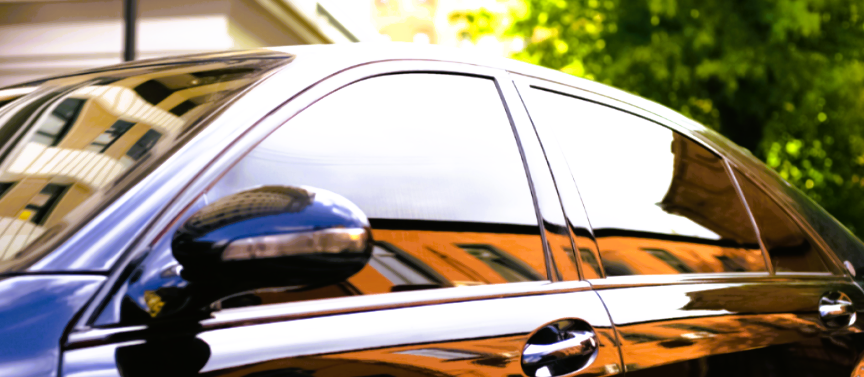
Enhanced Privacy and Security
- Protection from Prying Eyes: One of the primary benefits of window tinting is the increased privacy it affords passengers and belongings inside the vehicle. Tinted windows make it difficult for outsiders to see into the car, allowing occupants to feel more secure. This is particularly beneficial for families with children or when traveling frequently.
- Increased Security for Valuables: Tinted windows help protect valuables left inside the vehicle from being easily visible to thieves. When would-be criminals can’t see items of interest through the windows, they are less likely to break in. This added layer of security can be crucial in safeguarding personal belongings.
UV Protection and Heat Reduction
- Block Harmful UV Rays: Window tinting significantly reduces the amount of ultraviolet (UV) radiation that enters the vehicle. By blocking up to 99% of UV rays, window tint protects the skin from sun damage and minimizes the risk of skin-related health issues, such as skin cancer.
- Keep the Vehicle Cooler: Tinted windows help regulate the temperature inside the vehicle by reflecting or absorbing heat from sunlight. This results in a cooler cabin, reducing the reliance on air conditioning and enhancing comfort for passengers, especially in hot weather conditions.
Glare Reduction
- Improve Visibility While Driving: Window tinting effectively reduces glare from the sun and headlights of oncoming vehicles. This enhances visibility for the driver, making for a safer driving experience, particularly during bright daylight or at night.
- Reduce Eye Strain: By minimizing glare, tinted windows can help reduce the strain on a driver’s eyes, allowing for a more comfortable and less stressful driving experience. This is particularly beneficial for long trips or daily commutes during bright sunny days.
Aesthetic Appeal
- Customizable Look for the Vehicle: Window tinting provides an opportunity for vehicle owners to customize the look of their vehicles. With various shades and styles available, drivers can choose a tint that matches their aesthetic preferences, enhancing the visual appeal of their ride.
- Potential Increase in Resale Value: Well-executed window tinting can enhance the overall appearance of the vehicle, possibly increasing its resale value. Many potential buyers appreciate the benefits of tinting, including improved comfort, aesthetics, and protection, which can make a vehicle more attractive on the used car market.
In summary, the benefits of window tinting extend beyond mere appearance; it enhances privacy and security, provides crucial UV protection and thermal comfort, improves visibility and reduces eye strain, and adds a touch of aesthetic value that can pay off in the long run. Investing in quality window tinting presents a practical solution for anyone looking to enhance their driving experience while protecting their vehicle and its occupants.
Legal Considerations for Window Tinting
Overview of Tinting Laws and Regulations by State or Region
Window tinting laws vary significantly across different states and regions, making it essential for vehicle owners to familiarize themselves with local regulations before applying tint. These laws typically specify:
- VLT (Visible Light Transmission) Percentage: This is the percentage of visible light that must be allowed to pass through the window. Each state may have different legal limits for the front windshield, side windows, and rear windows. For example, some states may allow only 25% VLT on the front windows while allowing darker tints on rear windows.
- Windshield Tint: Many states have restrictions on the use of tint on the front windshield, often permitting only a strip along the top (known as the “eyebrow” strip) or requiring that the windshield remains nearly clear.
- Reflection: Some states regulate the level of reflectivity in window film. Tints that are highly reflective may not be allowed, ensuring that drivers are not blinded by glare from their own windows.
- Medical Exemptions: Certain regions have provisions for medical exemptions, allowing individuals with specific health issues to apply for darker tints than normally permitted under the law.
It’s crucial to consult local regulations or speak with a professional tinting service familiar with state laws to ensure compliance.
Importance of Complying with Legal Limits
Complying with window tinting laws is essential for several reasons:
- Safety: Tinting laws are often established with safety in mind. Properly regulated tint levels ensure that drivers maintain adequate visibility, reducing the risk of accidents caused by impaired vision.
- Legal Compliance: Adhering to local laws prevents any legal issues that may arise from having excessively dark or illegal tints. Non-compliance can result in fines, citations, or required removal of the tint.
- Insurance and Liability: In some cases, having illegal window tinting may affect insurance coverage. If a driver gets into an accident and the tint is found to be illegal, it could complicate claims and lead to liability issues.
Consequences of Illegal Tinting
There are several potential consequences for failing to comply with window tinting laws:
- Fines and Penalties: If stopped by law enforcement for illegal tinting, drivers may face fines that vary by jurisdiction. Repeat offenses can lead to increased fines and penalties.
- Vehicle Inspections and Citations: In some areas, vehicles may be required to undergo inspections, and non-compliance with tint regulations can lead to citations and require immediate corrective actions.
- Removal of Tint: Law enforcement may require that illegal tints be removed, which could involve additional costs for the vehicle owner for professional removal services.
- Insurance Issues: Illegal tinting can complicate insurance claims and might even lead to higher premiums or denial of coverage if the tint is found to be against policy requirements.
To avoid these complications, it’s crucial for vehicle owners to stay informed about their local tinting laws, properly select tint levels that comply with regulations, and work with reputable professional tinting services that understand and follow the legal guidelines. By doing so, car owners can enjoy the full benefits of window tinting without the hassle of legal issues.
Choosing the Right Tint for Your Vehicle
Factors to Consider
When selecting the right tint for your vehicle, several factors should be taken into account:
- Percentage of Tint (VLT – Visible Light Transmission):
- Determine the legal limits for VLT in your state or region. Decide how dark you want your windows while remaining compliant. Common VLT percentages range from 5% (very dark) to 50% (more transparent).
- Consider your personal preferences for privacy versus the legal limitations. Remember that darker tints can significantly improve privacy but may reduce visibility, especially at night.
- Type of Film:
- Choose from various types of window film—dyed, metalized, ceramic, hybrid, or carbon. Each type has its unique benefits:
- Dyed Film: Affordable but may fade over time.
- Metalized Film: Reflective and durable, with good heat rejection.
- Ceramic Film: Offers the highest quality in terms of heat rejection and UV protection without diminishing visibility.
- Carbon Film: Provides a matte finish and does not fade, while effectively blocking heat.
- Choose from various types of window film—dyed, metalized, ceramic, hybrid, or carbon. Each type has its unique benefits:
- Professional vs. DIY Installation:
- Professional Installation: Many vehicle owners opt for professional services to ensure a precise application and compliance with laws. Professionals typically have experience, tools, and access to higher-quality films, which can result in a better overall outcome.
- DIY Installation: If you choose to do it yourself, research and purchase high-quality tint film and ensure you understand the installation process thoroughly. Keep in mind that improper installation can lead to bubbles, peeling, or legal issues if tinting is not within regulations.
How to Choose a Reputable Tinting Service?
Selecting a trustworthy tinting service is crucial for a satisfactory result. Consider the following:
- Experience and Reputation: Look for a company with a solid history and positive customer reviews. Ask friends or family for recommendations or check online reviews and ratings.
- Portfolio of Work: Many tinting companies will showcase their previous work. Review their portfolio to see the quality of their installations and what types of vehicles they have worked with.
- Warranty and Guarantees: A reputable tinting service should offer warranties on both the installation and the tint film. This protects your investment and gives you peace of mind.
- Certifications and Training: Verify that the technicians are trained and certified in window tinting. Well-trained professionals are more likely to deliver high-quality results.
Questions to Ask Before Getting Your Windows Tinted
Before proceeding with window tinting, ask the following questions to ensure you make an informed decision:
- What types of films do you offer, and what are their benefits?
- Understanding the differences in the film types and how they align with your needs will help you make the right choice.
- What is the legal limit for window tint in our area?
- Ensure the tinting service is knowledgeable about local regulations to prevent any legal issues with your tinting choice.
- What percentage of tint do you recommend for my needs?
- An experienced technician can help guide you to the best VLT for your privacy, comfort, and legal compliance.
- Do you offer a warranty for the film and installation?
- Confirm the length and details of any warranties provided.
- Can you provide references or customer testimonials?
- Hearing from past customers can give you insight into the service quality and experience.
- How long will the installation take, and what should I expect afterward?
- Knowing the timeline and post-installation care (like curing times and whether you can roll the windows down) is essential for planning.
- What is the total cost, including installation? Are there any hidden fees?
- Be clear about pricing and any potential additional costs to avoid surprises.
By considering these factors and asking the right questions, you can make an informed choice when selecting window tint for your vehicle that meets both your aesthetic preferences and legal requirements.
The Tinting Process
Step-by-Step Explanation of What to Expect During the Tinting Process
- Consultation:
- Begin with a consultation with the tinting service to discuss your preferences, legal limitations, and film options. The technician will help you decide on the tint levels and types that best suit your needs.
- Preparation:
- The technician will prepare your vehicle by cleaning the windows thoroughly to remove any dust, dirt, or residues. This step is crucial as it ensures proper adhesion of the tint film and prevents bubbles or imperfections.
- Cutting the Tint Film:
- After cleaning the windows, the technician will carefully measure and cut the tint film to fit each window. Some professionals may use pre-cut kits, while others will cut the film directly on the vehicle.
- Application of the Tint Film:
- The technician will then apply the tint film onto the window using a special solution to create a smooth surface for installation. They will carefully position and squeegee the film to remove air bubbles and ensure a tight fit.
- Trimming:
- After applying the film, the technician will trim any excess material around the edges of the window for a clean, finished look. This step ensures that the tint is applied precisely and neatly.
- Curing Process:
- The windows will need time to cure. The technician will provide you with guidance on when it’s safe to roll down the windows or clean them after application.
Duration of the Process
The entire tinting process typically takes between 1 to 4 hours, depending on factors such as:
- The number of windows being tinted.
- The type of film selected.
- The experience of the technician.
- Any complexities involved, such as factory-tinted windows or specialty films.
For larger vehicles, like SUVs and vans, the process may take longer due to the additional window area that requires treatment.
Aftercare and Maintenance Tips
Proper aftercare and maintenance are essential to ensuring the longevity and effectiveness of your window tint. Follow these tips:
- Wait to Roll Down Windows:
- Usually, you should refrain from rolling down your windows for at least 3 to 5 days post-installation. This allows the film to properly adhere and cure without being disturbed.
- Avoid Cleaning the Windows Immediately:
- Wait at least 2 weeks before cleaning the tinted windows to allow the film to set completely. When you do clean them, avoid using ammonia-based cleaners, as these can damage the tint.
- Use Soft Cleaning Materials:
- Use a soft cloth or microfiber towel for cleaning. Avoid rough sponges or abrasive materials that could scratch the film.
- Regular Cleaning:
- Regularly clean the tinted windows with soap and water or a cleaner specifically designed for tinted windows. This helps maintain clarity and appearance.
- Avoid Direct Sunlight Post-Application:
- Try to park in shaded areas or garages during the first few days after installation to prevent excessive heat from affecting the tint during the curing stage.
- Check for Bubbles or Peeling:
- Occasionally inspect the film for any bubbles, peeling, or changes in color. If you notice any issues, contact the tinting service for guidance or possible repairs.
By understanding the tinting process, the expected duration, and following aftercare tips, you can ensure a smooth experience and maintain the quality of your window tint for years to come.
Common Myths and Misconceptions About Window Tinting
Window tinting has become increasingly popular among vehicle owners, but misconceptions and myths surrounding it often lead to misunderstandings. Here, we debunk some of the most common myths and clarify misconceptions about window tinting durability and effectiveness.
Debunking Myths
- Myth: Tinting Reduces Visibility
- Truth: While darker tints do limit visibility, modern window films are available in various shades that provide privacy without significantly obstructing the driver’s view. In fact, many high-quality films are designed specifically to reduce glare and enhance visibility, especially during bright sunlight conditions.
- Myth: All Tints Are Illegal
- Truth: Many people believe that all window tints are against the law, but laws vary significantly by region. Most places have specific regulations regarding the percentage of tint allowed on different windows. It’s important to check local laws and choose a film that complies with these regulations. Licensed professionals are usually knowledgeable of these laws and can help you stay within legal limits.
- Myth: Tinting Makes Windows Shatterproof
- Truth: While window film can increase the strength of glass and hold shattered pieces together, it does not make windows truly shatterproof. The primary function of tint is to block UV rays and reduce heat and glare. For enhanced safety, consider additional security films designed specifically to provide more protective features.
- Myth: Tinted Windows are Always Dark
- Truth: Many assume that window tinting must be dark, but this is not the case. There are a variety of film types with varying levels of darkness and visibility. Clear or lightly tinted films can still provide UV protection and heat reduction, maintaining visibility while giving a subtle upgrade.
Clarifying Misconceptions About Tint Durability and Effectiveness
- Misconception: All Tints Are the Same
- Truth: The durability and effectiveness of window films can vary greatly based on the type and brand chosen. Higher-quality films, like ceramic and carbon films, generally offer better performance in terms of UV protection, heat rejection, and durability compared to cheaper dyed films. Investing in reputable brands pays off in longevity and effectiveness.
- Misconception: Tints Will Fade Quickly
- Truth: While some lower-quality dyed films can fade and deteriorate over time, many modern films come with UV protectants and advanced technologies that resist fading and are designed to last for years without significant color change. When selecting a tinted film, look for products with warranties that specify expected longevity.
- Misconception: Tinting Eliminates Heat Completely
- Truth: Although window tinting significantly reduces heat and UV exposure, it does not eliminate it entirely. However, high-quality tints can lower cabin temperatures dramatically, improving comfort and decreasing the need for air conditioning, which can enhance fuel efficiency.
- Misconception: Tinting Will Ruin My Vehicle’s Interior
- Truth: High-quality window tint can actually protect the vehicle’s interior from damage. By blocking UV rays, tints help prevent fading and cracking of upholstery, dashboards, and other surfaces. Choosing the right product can enhance interior longevity rather than detract from it.
By debunking these myths and clarifying misconceptions about window tinting, vehicle owners can make informed choices that enhance their driving experience. Understanding the true advantages of window tinting will help individuals appreciate its benefits while bypassing the myths that might otherwise deter them from benefiting from this valuable addition to their vehicles.
Cost of Window Tinting
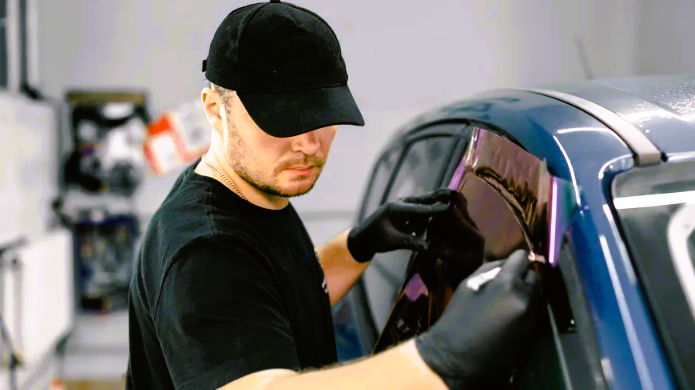
When considering window tinting for your vehicle, understanding the associated costs is crucial in planning your budget and assessing the value it brings. Here’s a breakdown of average pricing, factors influencing costs, and a cost-benefit analysis.
Average Pricing for Different Types of Tinting
The average cost of window tinting can vary based on several factors, including the type of film, the number of windows being tinted, and the vehicle type. Here’s a general breakdown:
- Standard Dyed Film:
- Price Range: 100−100−300 for a sedan; 200−200−400 for SUVs and vans.
- Overview: The most affordable option, providing basic heat and UV protection, but with a tendency to fade over time.
- Metalized Film:
- Price Range: 200−200−400 for a sedan; 300−300−600 for SUVs and vans.
- Overview: Offers better durability and heat rejection than dyed films. It includes metal particles for enhanced reflectivity and protects against fading.
- Carbon Film:
- Price Range: 250−250−500 for a sedan; 400−400−700 for SUVs and vans.
- Overview: Provides excellent heat rejection and does not fade over time. Offers a matte finish that many find appealing.
- Ceramic Film:
- Price Range: 400−400−800 for a sedan; 600−600−1000 for SUVs and vans.
- Overview: The highest quality option, offering superior heat rejection and UV protection without compromising visibility. It is also the most expensive.
- Additional Options:
- Specialty films (e.g., reflective, security) or films with added privacy features can increase overall costs.
Factors That Influence the Cost
Several key factors can impact the overall cost of window tinting, including:
- Vehicle Size:
- Larger vehicles, such as trucks and SUVs, typically have more window surface area, leading to higher costs due to increased labor and materials.
- Type of Film:
- As previously mentioned, different types of films have varying costs, with premium films (ceramic or carbon) tending to be significantly more expensive than basic dyed films.
- Service Provider:
- Established and reputable tinting services may charge higher rates due to the quality of their work, products, warranties, and customer service. It’s essential to consider both cost and quality when choosing a provider.
- Number of Windows:
- The more windows you have tinted, the higher the cost. Many services offer bundle deals for the entire vehicle, which may save you money compared to tinting individual windows.
- Additional Features:
- If you desire additional services, such as heating or reflective coatings, those will also contribute to the overall expense.
Cost vs. Benefits Analysis
When weighing the cost of window tinting against its benefits, consider the following:
- Enhanced Comfort:
- Tinted windows can significantly reduce heat buildup in your vehicle, leading to a more comfortable driving experience, especially in hot climates. This comfort can contribute to a more enjoyable ride and decreased reliance on air conditioning, potentially saving on fuel costs.
- Improved UV Protection:
- High-quality window films block up to 99% of harmful UV rays. This protection can help reduce skin cancer risk and significantly protect your vehicle’s interior from fading and cracking, preserving its value over time.
- Increased Privacy:
- Tinted windows provide an added layer of privacy and security for both passengers and belongings within the vehicle. This deterrence can discourage potential theft and enhance your sense of comfort.
- Aesthetic Appeal:
- Window tinting can enhance the appearance of your vehicle, giving it a sleek, custom look that many drivers desire.
- Resale Value:
- Well-installed window tint can maintain your vehicle’s interior condition, which can contribute to increased resale or trade-in value.
While the upfront cost of window tinting varies based on several factors, the long-term benefits—such as increased comfort, UV protection, and potential savings on energy costs—make it a worthwhile investment for many vehicle owners. By carefully considering the different options and their associated costs, you can select a window tinting solution that best fits your needs and budget.
The Art and Impact of Vehicle Car Stickers 2024
NITHIN FERNAND
Finding Vehicle Window Tinting Services Near You
When it comes to enhancing your vehicle with window tinting, finding a reliable service provider is crucial. The quality of installation and the materials used can significantly affect the performance and appearance of your window tint. Here are some tips for locating reputable vehicle window tinting services near you.
Tips for Searching Local Tinting Services
- Online Reviews:
- Check websites like Google, Yelp, or Angie’s List for customer reviews of local tinting services. Pay attention to the overall ratings and read through individual reviews to get a sense of consistent themes regarding service quality, professionalism, and customer satisfaction.
- Look for reviews that mention specific aspects like installation quality, product durability, and post-installation support.
- Recommendations:
- Ask friends, family, or coworkers for recommendations. Personal experiences can provide insights into reputable local shops.
- Visit local car clubs or online forums dedicated to automotive topics; members often share their experiences and can suggest trusted tinting services in your area.
- Social Media and Community Groups:
- Utilize platforms like Facebook or Nextdoor to seek local recommendations. Many communities have groups dedicated to local services where members can offer insights and reviews.
- Website Exploration:
- Visit the websites of potential service providers to learn more about their offerings, materials used, and any specialized services they may provide, such as warranty services or mobile tinting options.
Importance of Comparing Prices and Services
Before making a decision, it’s wise to compare different services and pricing:
- Request Quotes:
- Contact multiple tinting services to get quotes. Pricing can vary substantially based on factors like film type, the number of windows, and whether the service includes any additional features.
- Evaluate Packages:
- Some tinting services may offer bundled packages at reduced rates. Compare what each package includes, such as different film types or warranties.
- Look Beyond Price:
- While cost is an important factor, the cheapest option is not always the best. Consider the quality of materials used, the reputation of the shop, and the experience of their technicians before making a final decision. This approach can save you money in the long run by avoiding poor-quality installations that may need to be redone.
Highlighting the Importance of Warranty and Service Quality
- Warranty:
- Ask about the warranty offered on both the film and the installation. A reputable tinting service will usually provide a warranty that covers issues such as fading, bubbling, and peeling.
- Read the warranty terms carefully to ensure you understand what it covers and for how long. This can provide peace of mind and protect your investment.
- Service Quality:
- Inquire about the experience and training of the technicians. Skilled professionals are more likely to deliver a high-quality installation that meets industry standards.
- Visit the shop, if possible, to observe the workspace and gauge their professionalism and cleanliness. A well-organized, professional environment often reflects the care they put into their work.
- Post-Installation Support:
- Good tinting services should offer guidance on caring for your newly tinted windows to ensure longevity. They should be readily available for follow-up questions or concerns after the installation.
By following these tips and considering these factors, you can find a reputable vehicle window tinting service that meets your needs and enhances your ride. Enjoy the benefits of high-quality window tinting, knowing you made an informed choice!
Conclusion
In summary, professional window tinting offers a multitude of benefits that can greatly enhance your driving experience and the longevity of your vehicle. From improved comfort due to heat reduction to enhanced UV protection that safeguards both your health and your vehicle’s interior, the advantages are compelling. Additionally, window tinting provides increased privacy and aesthetic appeal, contributing to a personalized and sleek look that many vehicle owners desire.
As you consider the options available to enhance your ride, take the time to explore the various types of window films, their unique properties, and the different installations. Evaluating the legal requirements in your area and the potential benefits of a professionally done job will aid in making an informed decision.
We encourage you to take the next step in upgrading your vehicle. Visit local window tinting providers to discuss your desires and needs, schedule consultations to get personalized quotes, and conduct further research into the best window tinting options available. Your vehicle deserves the best, and the right window tint can make all the difference. Enjoy the journey of enhancing your ride with the many benefits of professional window tinting!
Additional Resources
To assist you further in your journey toward enhanced vehicle comfort and style through window tinting, we’ve compiled a list of valuable resources that provide important information, trusted products, and professional services.
1. State Legal Guidelines on Window Tinting
Understanding the legal regulations in your state regarding window tinting is essential before making any decisions. Here are some resources where you can find the specific guidelines:
- Tinting Law Websites:
- IJustGotTinted.com – A comprehensive resource for up-to-date laws on window tinting across all 50 states.
- WindowTintLaw.com – Offers detailed information about state-specific laws including allowable tint percentages and reflective limits.
- State Department of Motor Vehicles (DMV) Websites:
- Check your local DMV website for detailed legal guidelines and regulations related to window tinting.
2. Recommendations for Trusted Tinting Product Brands
When selecting window tinting products, it’s crucial to choose reputable brands known for their quality and durability. Here are some trusted names in the industry:
- 3M: Known for innovative and high-performance window films that offer excellent UV protection and heat rejection.
- Llumar: Offers a wide variety of window films with great durability and performance options for both commercial and residential applications.
- Solar Gard: Provides a diverse range of window films, including specialty films designed for various needs like security and aesthetics.
- Huper Optik: Specializes in ceramic films that provide superior heat reduction while maintaining clarity and visibility.
- Madico: A trusted brand with a range of films offering excellent protection, clarity, and fade resistance.
3. Contact Information for Professional Tinting Services
For the best results, professional installation is recommended. Here are resources to help you find local tinting services:
- Google Maps & Local Directories: Search for “window tinting services near me” to find highly-rated local providers. Be sure to check reviews for customer experiences.
- Yelp: A reliable platform to read reviews and find recommendations for reputable tinting services in your area.
- Tint World: A national chain specializing in window tinting and other vehicle enhancements. Visit their website (www.tintworld.com) to find a location near you.
- Local Automotive Shops: Many automotive repair and enhancement services also offer window tinting. Visit them or check their websites for more information.
With these resources at your disposal, you are now better equipped to navigate the world of vehicle window tinting. Whether you’re looking for legal information, trusted products, or professional installation, these tools can assist you in making informed decisions that enhance your ride. Happy tinting!
FAQs
1.Which hue resists heat the best?
Ceramic Tint
One of the greatest options for window tinting is ceramic tint because these films are aesthetically pleasing, high-quality, and quite effective. Up to 50% of solar heat and 99% of UV rays can be blocked by ceramic window tint in terms of heat and UV rejection.
2.Which tinting firm is the best?
1) 3M. In the automobile product industry, 3M is a well-known brand, and their window tints live up to the hype.
2) Solar Gard.
3) XPEL.
4) Avery Dennison.

